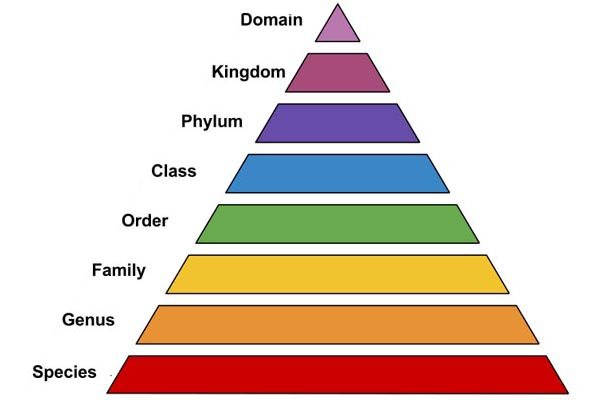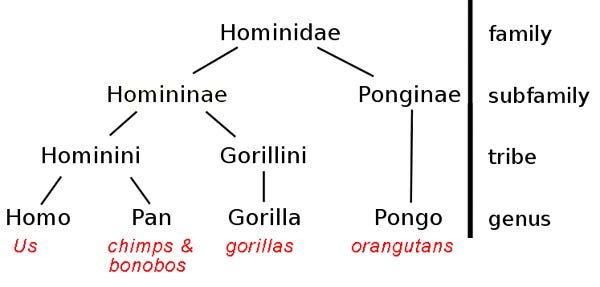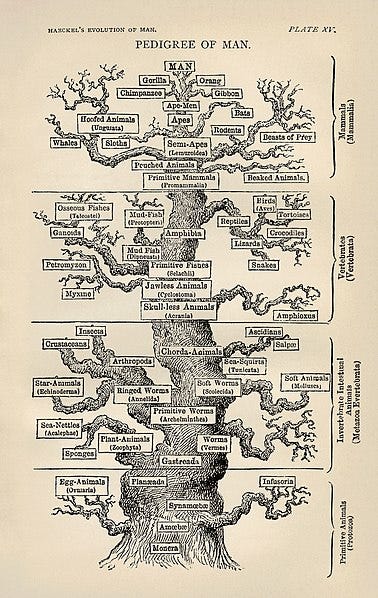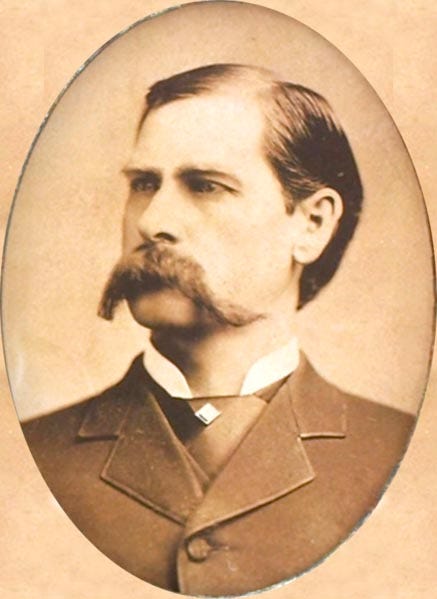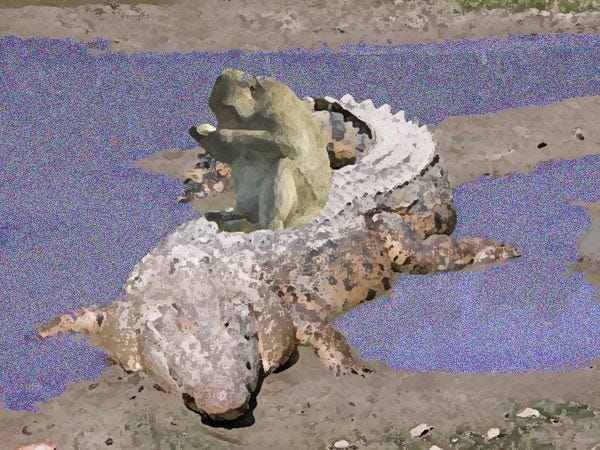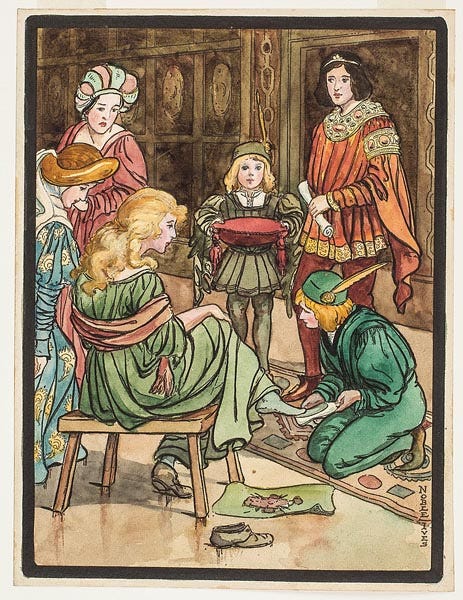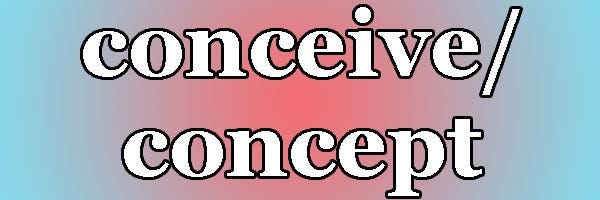Vol. I, Is. 4: Odysseus and the Cyclops... and more!
Human Taxonomy, Wyatt Earp, "Monkey and Crocodile," "Little Boy Blue"
Welcome to Volume I, Issue 4, of The Jim Bucket List, an encyclopedic look at the things that "everybody ought to know"!
Today's topics:
LITERATURE: Odysseus and the Cyclops
SCIENCE: You Are Here: Human Taxonomy
HISTORY: The "Legend" of Wyatt Earp
FOR YOUNG READERS: "The Monkey and the Crocodile" from The Panchatantra
READ-ALOUD-RHYME: "Little Boy Blue"
A WORD TO THE WISE: "If the shoe fits, wear it"
VOCABULARY BUILDER: conceive and concept
THIS WEEK'S BIRTHDAYS: Nov. 22-28
Let's go!
LITERATURE: Odysseus and the Cyclops

Listen to the audio of this article:
Odysseus and the Cyclops
"Clever Odysseus," as he was known, was one of the Greek leaders in the Trojan War. Indeed, he it was who devised the Wooden Horse that brought about the fall of Troy.
But on his way home, through offending the gods, Odysseus and his men were blown off course and forced to wander for ten years, having many harrowing adventures along the way. One of the most famous adventures of this "odyssey" was his meeting with a one-eyed giant--a Cyclops--named Polyphemus, meaning "[having] many songs and legends." In other words, he was famous.
Oblivious to any danger, Odysseus and his men landed on a remote island and entered a cave where, after helping themselves to some food and drink, they fell asleep. But while they slept, Polyphemus returned to that very same cave, leading his flock of giant sheep. As usual, he rolled a huge stone across the cave's entrance to keep the sheep in. Finding the men--and ignoring customs of hospitality, for the Cyclopes were a lawless folk--the Cyclops immediately dined on two of them. The Cyclopes were also man-eaters!
[Note: Cyclops--SY klopps--is singular; Cyclopes--sy KLOH peez--is plural]
Just as the men had, the sated Cyclops fell asleep, but still it was impossible for the men to escape: the stone covering the doorway was too large for them to move. What to do?
The next morning, after gobbling down two more men, Polyphemus again took his flocks out--being careful this time to "close the door" behind him. While he was out, clever Odysseus devised a cunning plan.
When the giant returned, and again dined on two men, Odysseus offered him some stronger-than-usual wine, which got him very drunk (so uncivilized were the Cyclopes that they had never developed alcoholic beverages, so he got drunk easily). Grateful, the drunken Cyclops asked Odysseus his name, and again showing his cleverness Odysseus answered Outis (in Latin, Nemo), meaning "no man." The drunken Polyphemus, promising as a favor to eat his new friend last of all, fell asleep again.
But while the Cyclops was out, Odysseus and his men had sharpened a large stake. Once Polyphemus was snoring, they heated the stake in the fire and plunged it into the giant's single eye, blinding him. When Polyphemus bellowed for help, his friends came running. But when they called out asking who had attacked him and he said, "Nobody!" they returned home snorting derisively.
When the blind Cyclops was taking his flocks out again in the morning, he touched the back of each sheep to make sure none of the Greeks escaped, but Odysseus had tied his men under the sheep! He himself then clung to the underside of the ram, the largest of them. Once they had ridden out of the cave this way and were sailing away free, Odysseus shouted back his real name. Lobbing huge boulders at the ship, the giant called on his father Poseidon for help. This would bring the Greeks further trouble later in their journey.
--------
PRACTICE:
Vocabulary: Match the words to their meaning. Answers below.
1. boulders
2. derisively
3. gobbling
4. lobbing
5. oblivious (to)
6. odyssey
7. plunged
8. remote
9. sated
10. stake
A. far from anything
B. throwing in a high arc
C. unaware (of)
D. a long wandering adventure
E. eating quickly; gulping
F. strong, pointed stick
G. satisfied; full
H. mockingly
I. huge stones
J. pushed with force
QUESTIONS TO ANSWER
Answer the following questions in your own words. Suggested answers below.
1. What was Odysseus's nickname?
2. What is the meaning of the name "Polyphemus"? Why?
3. What kinds of beings were the Cyclopes?
4. What was Odysseus's plan to escape the Cyclops?
5. Who was Polyphemus's father?
QUESTIONS TO THINK ABOUT:
These questions do not have "right" or "wrong" answers. They only ask your opinion.
1. If you think about it, Odysseus and his men caused the first offence by entering the Cyclops's "home" and eating his food and drink without permission. Do think this was right?
2. Why do you think Odysseus called himself Outis (Nemo), since he couldn't have known about Polyphemus saying "No man has hurt me!" later?
3. Why do you think Odysseus taunted Polyphemus by telling him his real name?
SCIENCE: You Are Here: Human Taxonomy
Listen to the audio of this article:
You Are Here: Human Taxonomy
As I'm sure you're aware, you and I and every person we know is referred to scientifically as Homo sapiens, which can be translated as "the hominid who knows." (We'll get to "hominid" in a minute.) Others have translated it "knowledgeable man" or even "wise man." (But it seems to me that saying "man" here begs the question.)
These two words, Homo and sapiens, are the genus and species of humans. There are (or actually were) other species in our genus, but we are, as it were, the last men standing.
Carl Linnaeus, the Swedish scientist who came up with the original naming system on which the one we use today is based, declared that all living beings would be referred to by both genus and species (this is called binomial nomenclature, or "two-named naming), though taken together they are called "the species name." So the species name of
one kind of hummingbird is Topaza pella (topaz is a gemstone; pellus is Latin for "dark-colored");
a certain water buffalo, Bubalus bubalis (from Greek boubalos meaning "buffalo");
a type of orchid, Ophrys apifera (the "bee orchid"); and
the giant sequoia tree, Sequoiadendron giganteum (the "giant tree of Sequoia," also called the giant redwood, among other names).
(Not to confuse you, but sometimes another, third, word is added to describe a subspecies, but never mind.)
Notice also that the genus name is always capitalized, and the species (or subspecies) is not. In fact, the names of any members of ranks above genus are always capitalized. For example, the water buffalo is in the family Bovidae (which includes cows, sheep, antelopes, and the like). (All names of ranks, including the species, are customarily italicized.)
Okay, but how are we related to hummingbirds, buffaloes, orchids, and sequoias, let alone bacteria and whatnot? In a moment we'll begin our slow climb up the family tree, from the most specific grouping - us - to the largest, but first let's get a little background.
--------
Taxonomic Ranks
For the moment, let's start at the top and climb down to us. The largest divisions of living things are the domains, of which there are only three. (There is in fact a category outside of any domain--the viruses--though some dispute that they are "living" in any full sense of the word. We'll get to that.)
By the way, taxonomy is the science of categorization or classification. The units of classification are called taxa (singular taxon); -nomy, or course, means the "laws" or "science" of something. The word can be used generally for classifying things like library books, but here we're talking about a "hierarchical classification of living things."
Next are the kingdoms, of which there are five (usually), though most of us only think of the animal and plant kingdoms.
Continuing downward, in zoology we have the phyla (singular phylum), which in botany are called divisions. In the five-kingdom system, there are something like 31 phyla of Animals and 14 divisions of plants. For completeness's sake, let me add that there are 8 of Fungi, 19 of Protista, and 29 of Bacteria. Again, more details later.
Below phylum on our Ladder of Life is class. Things start to get messy here; as we get up to larger and larger groups, there are more of what we might call "inter-ranks." For example, around "class" we have superclass above; then subclass, infraclass, subterclass, and parvclass below. We will not spend a lot of time on these details!
Let's speed on down the ranks. The lowest four categories are orders (which may have superorders and/or suborders), families (with superfamilies, subfamilies, tribes, and subtribes), and the genus and species we've already met, the latter of which (as mentioned) may have a subspecies.
Let me note here that nothing in the science of taxonomy is fixed. New knowledge brings new classifications, and taxonomists may even disagree on what belongs where at any given moment. The introduction of DNA, a more certain indicator than physical descriptions, has revolutionized this science.
If you're planning to memorize the eight ranks, here's one of the many mnemonics used by students:
"Dear King Philip Came Over For Good Soup."
Look at the initial letters: they'll remind you of:
Domain, Kingdom, Phylum, Class, Order, Family, Genus, and Species.
Right? By the way, botanists can use "Dear King David" (remember they have Divisions) for "Dear King Philip."
Now that you've learned the eight ranks (can you name them?), let's move on to us.
--------
Human Taxonomy
We will now climb up our family tree, from the specific to the general.
Genus and Species: We have already discussed our full species name (genus + species), but let's take a closer look at the genus name Homo.
Homo is the Latin word for man, as seen in the Latin translation of Pontius Pilate's words "Behold the man": Ecce homo (which has become a motif in religious art). It should not be confused with the Greek root homo-. meaning "same," as in homogeneous and homosexual. Latin Homo is the source word for human, and in turn may have come from humus meaning "earth" or "soil."
We are the only extant example of the genus Homo; all others have gone extinct. The first emerged from the genus Australopithecus, let's say a couple of million years ago. The earliest known Homo was Homo habilis ("handy man"--heh heh). Others include Homo erectus ("upright man," who stood erect) and the famed Neanderthal Man, Homo neanderthalensis. All of these seem to have lived in groups whose lifestyles we might recognize; by the time of H. erectus we were probably living in societies of hunter-gatherers and using fire. (Everything this far back must be stated as "probable"; science itself evolves!)
Australopithecus went extinct not too long after Homo emerged. H. erectus may have gone "extinct" around a half a million years ago, probably by diverging into new species. H. habilis stuck around until around 1.65 million years ago, and H. neanderthalensis seems to have lived for quite some time side-by-side with us: they were here until around 40,000 years ago, and may have gone extinct through climate change, disease, or--very possibly--interbreeding with us.
The "chain" of our development looks like: Australopithecus --> H. erectus --> us. H. habilis and Neanderthal Man were on lateral branches.
We, the "anatomically modern humans," emerged roughly a quarter of a million years ago, probably in Africa. We then migrated into areas of Asia and Europe already occupied by Neanderthals.
A dictionary article describes us as "bipedal primates" characterized by
a large brain, a nearly vertical forehead, a skeletal build lighter and teeth smaller than earlier humans, and dependence upon language and the creation and utilization of complex tools.
(We'll talk more about primates in a minute.)
--------
Family: Hominidae. These are the "great apes," sometimes called in English "hominids." Aside from our genus, Homo, there are three other genera (the plural of genus): the Pongos include three types of orangutan; there are two types of Gorillas; and two types of Pans (chimpanzees and bonobos).
Our family includes two sub-groups or "inter-ranks" into which we fall:
the subfamily Homininae and
the tribe Hominini.
Aside from our tribe, the subfamily Homininae includes the tribe Gorillini, the two species of gorillas (all tribes end in -ini).
And our tribe the Hominini has another genus besides us, the Pans (chimpanzees and bonobos). I hope this chart helps:
Don't trouble yourself too much about these details. I have included them here just to emphasize our close relatives. But in our long climb up the family tree, it's enough to know that we are of the Genus Homo and the family Hominidae.
--------
Order: Primates. Now here's a word you may have heard before. Along with the other Hominidae (the "great apes"), we belong with the gibbons, monkeys (New World and Old), tarsiers, lemurs, and lorises to the order of Primates. As the groups get larger (and our relationships get more remote), I'll give up trying to cover all the members. It's enough to say that we are in the suborder Haplorhini, along with all that I've named except the lemurs and lorises; and in the infraorder Simiiformes, which we call "simians": the "great apes" (the Hominidae plus gibbons), the monkeys, and us. No tarsiers, lemurs, or lorises; the simians are more humanoid.
--------
Class: Mammalia. Commonly known as "mammals," these are characterized by mammary glands for nursing the young with milk (mamma is the Latin word for "breast"), and are covered with hair or fur. We typically (but not always) have four limbs (the sea-going cetaceans, like dolphins and whales, have only two, modified into fins), and also typically (but not always) bear our young alive (the five species of monotremes, including the platypus, are egg-laying mammals).
Orders include rodents; bats; the Eulipotyphla (ground-dwellers like moles and shrews); Artiodactyla (including cetaceans and some hoofed animals); Carnivora (meat-eaters like big cats, wolves, and our mammalian companions, cats and dogs); and us Primates.
--------
Phylum: Chordata. This essentially means "critters that at some point in their development have a notochord," a structure along the back similar to a spine. If, as we do, that chordate has developed a backbone made up of vertebrae, it's called, as we are, a vertebrate. The vertebrates are a subphylum that includes about 69,963 species, from frogs to the blue whale, including all fish, amphibians, reptiles, birds, and mammals (that's us). There are other, invertebrate, chordates, mainly marine animals like sea squirts.
--------
Kingdom: Animalia. Now here's a word we use all the time: animals. For most of us, that means "living things that aren't plants," but it's a little more complicated than that.
That, however, was the way the ancients saw things--before microscopes, anyway. With the introduction of new equipment, though, scientists could see little things that seemed to be neither plant nor animal (or maybe both/and). They called these protista, a third kingdom.
Then, once they recognized that some microscopic critters had cell nuclei and some didn't, they named those with "eukaryotes" (that includes us) and those without "prokaryotes." The prokaryotes are now called Monera, and include bacteria. Today the Monera rest in their own domain called Prokaryota; the rest of us, including the Protista, Plantae, and Animalia are in the domain Eukaryota.
Finally, the Fungi were recognized as fundamentally different from plants (they do not carry out photosynthesis, for example) and so we now have a "five-kingdom system."
There have been suggestions of systems of six, seven, or even eight kingdoms, but five is the standard. These are, again:
Animalia
Plantae
Fungi
Protista (microscopic with cell nuclei)
Monera (microscopic without cell nuclei)
As for the Animalia, we can be recognized by the following traits: we usually consume organic material ("food"); breathe oxygen ("air"); are able to move intentionally; and can reproduce sexually. For the most part, we know an animal when we see one.
--------
Domain: Eukaryotes. The first four of the kingdoms just listed belong to the domain of Eukaryota (creatures with cell nuclei); the last is in the domain Prokaryota (those lacking nuclei). We, of course, are Eukaryotes.
But here's a peculiar thing, that makes simple family trees difficult to draw: there are three domains. The Eukaryotes are all in one; that's easy. But the Prokaryotes are actually split into two domains: molecular analysis has shown that the RNA markers in Bacteria are significantly different from the Archaea (such as the methanogens, which produce methane gas), the third domain.
This leads the discussion in a whole new direction, one which may not be very useful for us. But while we're off-roading, let's add that no one knows quite where to place viruses. They cannot replicate outside of living hosts, so there is some speculation that they may not be "living things" at all. Are they a form of life? Or merely an organic molecule? It's hard to say, but it does point out that taxonomy, like all science, can be slippery.
--------
Above all the ranks we've examined is the realm of life, or "all living things." We can say that rocks are not alive, and butterflies are. But the viruses make that distinction harder to prove.
Sticking with what we know, and using only the eight main ranks, we can say that we humans are members of the following, from the top down again:
Domain: Eukaryotes (which have cell nuclei)
Kingdom: Animalia (which eat food, breathe oxygen, move independently, and reproduce sexually)
Phylum: Chordata (which have a notochord at some point in development)
Class: Mammalia (which feed babies from mammary glands, have hair or fur, and usually bear live young)
Order: Primates (the great apes plus gibbons, monkeys, tarsiers, lemurs, and lorises)
Family: Hominidae (the great apes only--orangutans, gorillas, chimpanzees and bonobos, and us)
Genus: Homo (only us now, but many closely-related extinct ancestors and relatives)
Species: Homo sapiens
If I were to add one "inter-rank," I'd say it's most important to point out that we are of the Subphylum Vertebrata--creatures with backbones.
--------
And that just about wraps things up. You should now be able to point to our particular twig on the "Great Tree of Life," and say: "I am here!"
--------
PRACTICE:
Match the term for humans to its rank. Answers below.
1. Domain
2. Kingdom
3. Phylum
4. Class
5. Order
6. Family
7. Genus
8. Species
A. Primates
B. Animalia
C. Homo
D. Chordata
E. Homo sapiens
F. Mammalia
G. Eukaryotes
H. Hominidae
QUESTIONS TO ANSWER
Choose the best answer to the following questions. Answers below.
A giraffe is a member of the Class:
A. Mammals
B. Plantae
C. Prokaryotes
D. PrimatesA duck is a member of the Kingdom:
A. Plantae
B. Mammalia
C. Animalia
D. InvertebratesWhich rank is the highest (above the others)? Use the mnemonic!
A. Class
B. Family
C. Phylum
D. OrderHow many species of the genus Homo are alive today?
A. one
B. seven
C. 69,963
D. unknownHumans and orangutans belong to the same:
A. family
B. subfamily
C. tribe
D. genus
QUESTIONS TO THINK ABOUT:
These questions do not have "right" or "wrong" answers. They only ask your opinion.
1. Why do you think DNA is a more reliable guide to taxonomy than the observations of differences in organisms?
2. Why do you think other species in the genus Homo have all gone extinct? Could the same thing happen to us?
3. What practical value could there be in classifying every living organism on earth?
HISTORY: The "Legend" of Wyatt Earp
Listen to the audio of this article:
The "Legend" of Wyatt Earp
When I was a kid, one of the most popular TV shows amongst us boys was called The Life and Legend of Wyatt Earp. Centered on a supposed "hero" of that name, the show--and much of what we think about Wyatt--was more "legend" than "life" or solid biography.
Ask most people familiar with the name, and they'll tell you something like this: He was a "lawman" and the hero of the famous Shootout at the O.K. Corral in Tombstone, Arizona (which has made that virtual ghost town one of the most famous pilgrimage sites for fans of Westerns). The event was built up through the publication of "dime novels," cheap pamphlets read by daydreaming boys, followed later by films and TV shows. Later in life, Earp actively participated in the forging of his "legend."
The truth is a little seamier. Aside from his occasional work as a "lawman"--usually as an assistant to someone else--Earp derived much of his income from gambling and the operation of "bordellos"--houses of prostitution. He moved from one boomtown to another seeking jobs without much concern for which side of the law he was on.
Even the details of his most famous battle are shrouded in misunderstanding.
Wyatt was not the leader of the forces of "law and order" that day. Rather, the Clanton gang had caught the attention of City Marshal Virgil Earp, Wyatt's brother. They were a group of outlaw "Cowboys" who rustled Mexican cattle--Tombstone is only 30 miles (48 kilometers) from the border.
At 3 p.m. on October 26, 1881, after months of tension, three of the Earps (Wyatt and brother Morgan had been deputized) along with Wyatt's friend, a gambler and dentist named John Henry "Doc" Holiday, faced five (or six) members of the gang. (There are conflicting reports of what happened during and after the fight.) After 30 seconds of shooting near (but not at) the famed Corral, three of the Cowboys were dead, and Morgan and Virgil were wounded. Doc Holliday was grazed by a bullet, but Wyatt was unharmed.
This set off a vendetta in which, two months later, Virgil was ambushed, shot and crippled by unknown assailants. Nearly three months after that, in March of 1882, Morgan was fatally shot through the glass door of a saloon.
Wyatt was now a newly-minted deputy marshal, and set out to even the score. In the end, all the Clanton members were dead--and Wyatt was fleeing from a warrant on charges of murder. Leaving Tombstone for good, he continued his wandering life until settling down in Los Angeles, California, where he died at home at the age of 80 in January of 1929.
--------
PRACTICE:
Vocabulary: Match the words to their meaning. Answers below.
1. crippled
2. deputized
3. forging
4. grazed
5. newly-minted
6. prostitution
7. rustled
8. seamier
9. shrouded in
10. vendetta
A. hidden in; covered by
B. sex trade
C. stole (cows, horses, etc.)
D. appointed as a kind of assistant
E. recently created
F. creation
G. campaign of revenge
H. more sordid; of lower morals
I. incapacitated; disabled
J. scraped lightly
QUESTIONS TO ANSWER
Answer the following questions in your own words. Suggested answers below.
1. What helped create the "legend" of Wyatt Earp?
2. How did Earp make much of his money?
3. Who was the leader of the "lawmen" at the O.K. Corral?
4. What was the immediate outcome of the shootout?
5. What happened in the months after the shootout?
QUESTIONS TO THINK ABOUT:
These questions do not have "right" or "wrong" answers. They only ask your opinion.
1. Was Wyatt Earp a "hero"? What makes a person a hero?
2. Why do you think people love to hear legends, even when they're not true?
3. Can you think of other famous "heroes" who are not as great as many people believe?
FOR YOUNG READERS: "The Monkey and the Crocodile"
Listen to the audio of this article:
"The Monkey and the Crocodile"
This article is designed for younger readers, with activities more suitable for children. It is from an Indian collection of children's stories called The Panchatantra.
Once upon a time, a Monkey lived in a fruit tree next to a river. One day a Crocodile rested under the tree, and the Monkey gave him some fruit. The Croc thanked him and came back every day for more. The kind Monkey even sent some fruit home for Mrs. Croc.
She loved it, but said, "The Monkey eats this sweet fruit every day. Won't he also taste sweet? Please bring me his heart for a treat!"
The husband said, "The Monkey is my friend, Dear! I could never do that!" But his wife refused to eat anything else, and at last her husband agreed.
Next time he saw the Monkey, he said, "My wife loved the fruit so much that she would like you to come to our place for dinner." The Monkey agreed, but since he could not swim, the Crocodile carried him on his back. When they reached the deep water, the Croc told the Monkey the truth: "Actually, I'm taking you home to please my wife by giving her your heart!"
The Monkey said, "Why didn't you say so? I will gladly give your wife my heart if it will make you happy, my friend. But I left it at home in the tree. Let's go back and get it!"
The Crocodile was not as smart as the Monkey, and immediately turned around. When they reached the tree, the Monkey jumped from the Croc's back and climbed to the highest branches of the tree. When the Crocodile called out, "What's taking so long?" the Monkey replied, "Silly Croc! One cannot remove one's heart--and live! You tried to fool me, but instead I have fooled you!" The Crocodile was ashamed and swam away.
Some words to talk about:
ashamed: embarrassed; feeling sorry
gladly: happily; willingly
treat: something sweet to eat
--------
QUESTIONS TO ANSWER:
Choose the best answer. Answers below.
Why did the Crocodile come back every day?
A. Because his wife told him to.
B. Because he wanted to eat more fruit.
C. Because he wanted to eat the Monkey.Why did Mrs. Croc want to eat the Monkey?
A. Because she enjoyed eating monkeys all the time.
B. Because her husband told her monkeys are delicious.
C. She thought he would be sweet because he ate a lot of fruit.Why did the Croc agree to bring the Monkey to his wife?
A. Because she wouldn't eat anything until she got the Monkey.
B. Because she kept yelling at him.
C. Because he wanted her to cook the Monkey so he could eat it, too.Why did the Croc turn around after he had the Monkey on his back?
A. Because the Croc forgot something under the tree.
B. Because the Monkey told the Croc he had left his heart back in the tree.
C. Because the Croc wanted to get more fruit.What important idea did the Monkey tell the Crocodile at the end of the story?
A. A person or animal cannot live without a heart.
B. Crocodiles should always be ashamed of themselves.
C. Mrs. Crocodile was a bad wife.
QUESTIONS TO THINK ABOUT:
These questions do not have "right" or "wrong" answers. They only ask your opinion.
Why do you think the Monkey sent fruit home to the Crocodile's wife?
Why do you think the Croc decided to tell the Monkey the truth about his plan?
Why do you think the Croc believed the Monkey would give up his heart?
READ-ALOUD-RHYMES: "Little Boy Blue"
Listen to the audio of this article:
"Little Boy Blue"
Parents and teachers can read these rhymes aloud, and encourage little ones to repeat and even memorize them (I did when I was a kid!)
Little Boy Blue, come blow on your horn,
The sheep's in the meadow, the cow's in the corn.
Where is the boy who looks after the sheep?
He's under a haystack, fast asleep.
Will you wake him? Oh no, not I,
For if I do, he'll surely cry.Little Boy Blue, come blow on your horn,
The sheep's in the meadow, the cow's in the corn.
Where is the boy who looks after the sheep?
He's under a haystack, fast asleep.
Some words to talk about:
fast: soundly; deeply
haystack: a large pile of hay (straw to feed horses and cows)
meadow: here it probably means a place where hay is grown for later use
surely: certainly; for sure
under: here it means "at the base of," not actually under
ACTIVITIES
Kids growing up in rural places might be more familiar with the images and ideas in this rhyme. Have your kid: pretend to blow on a horn; act like a sheep or cow; "sleep" while you try to wake her or him (being "fast asleep"); and use a pile of clothes or other soft items for your kid to lie "under" (at the base of).
Discussion: Ask your kid if she or he knows what's wrong: What mistake did "Little Boy Blue" make? What happened because of that? In line 5 there's a change of speaker: someone seems to ask the first speaker a question, and the first speaker answers "no." Why does the speaker want to save the boy from crying?
Words to the Wise: "If the shoe fits, wear it"
Proverb: "If the shoe fits, wear it."
Sometimes we say only half of the proverb: "If the shoe fits..."
Meaning: Accept things the way they are. If you did something wrong, take the blame!
Some people think the expression may be related to the story of Cinderella, who lost a glass slipper at the Prince's ball, and became Princess when it was discovered that the "shoe fit." However, the original expression was, "If the cap fits…" and it has been suggested this was the dunce cap worn by poor students long ago.
Mini-Dialogue:
Eddie: "Christina just called me fat!"
Flo: "I'm not saying I agree, but if the shoe fits...!"
QUESTION:
In which situation would you use the proverb, "If the shoe fits, wear it"?
A. Your friend says he's been working hard and someone calls him lazy.
B. Your friend says his room is always clean and someone calls him a pig.
C. Your friend says he's failed all of his tests and someone calls him dumb.
Vocabulary Builder: conceive and concept
The words conceive and concept have a close relationship going back to Latin concipere and conceptum, both of which are based on words meaning "to seize" or "to take in fully."
Thus:
conceive (verb): to form something--an idea or a purpose (but also a baby!); imagine, believe, become pregnant with
concept (noun): something which has been conceived; a notion, idea,
I have mixed the derived words; an equal sign (=) means the words are near-perfect synonyms (i.e., they have the same meaning and usage).
Verb Forms: conceive=conceptualize; conceives=conceptualizes; conceived=conceptualized; conceiving=conceptualizing (but we never use the "conceptualize" forms for making a baby)
Noun Forms:
concept (plural concepts)=conception (plural conceptions): "We're looking forward to hearing your concept for the new building." ("Conception" is also the act of making a baby: "at the moment of conception.")
conceptualization (plural conceptualizations): the act or process of forming a concept: "We're behind schedule; the conceptualization of the new building is taking too long."
Adjective forms:
conceivable: imaginable: "We're taking every conceivable precaution."
inconceivable: unimaginable: "The cost of the new building is inconceivable."
conceptual: relating to a concept: "We're looking forward to seeing your conceptual drawings."
Adverb forms:
conceptually: relating to a concept, in front of an adjective: "The plan is conceptually impossible." (That is, the concept won't work.)
conceivably: able to be imagined: "The costs could conceivably run into the millions."
inconceivably: unable to be imagined: "The plan is inconceivably expensive."
--------
PRACTICE:
Place the correct form of "conceive" or "concept" in each sentence. Answers below.
1. There is no ________ way we can finish this project on time.
2. We might be finished soon, ________ by Christmas.
3. I'm trying to ________ a way to do this more cheaply.
4. He ________ the solution when the rest of us were still thinking about it.
5. If she ________ a new plan, let me know, will you?
6. They had trouble ________, so they decided to adopt.
7. I'm sorry, my ________ of the project is still unclear.
8. The ________ framework for the project is almost completed.
9. We need to hire a new architect; this one's ________ of the new building has been going on for months.
10. The new building's systems are ________ innovative.
11. That sort of rudeness in a formal situation is ________.
12. Our new boss is ________ intelligent.
A. conceive=conceptualize
B. conceives=conceptualizes
C. conceived=conceptualized
D. conceiving
E. concept=conception
F. conceptualization
G. conceivable
H. inconceivable
I. conceptual
J. conceptually
K. conceivably
L. inconceivably
THIS WEEK'S BIRTHDAYS: Nov. 22-28
The following "Great Minds" were born this week:
November 22
George Eliot (1819-1880) English novelist who wrote Adam Bede; The Mill on the Floss; Silas Marner; Middlemarch; and Daniel Deronda
André Gide (1869-1951) French author; L'immoraliste (The Immoralist); La porte étroite (Strait Is the Gate); Les caves du Vatican (The Vatican Cellars); La Symphonie Pastorale (The Pastoral Symphony); Les faux-monnayeurs (The Counterfeiters); Nobel Prize in Literature (1947)
Ross Calvin (1889-1970) American writer of the Southwest who wrote Sky Determines
Hoagy Carmichael (1899-1981) American composer; "Stardust"; "Georgia on My Mind"; "The Nearness of You"; "Heart and Soul"
November 23
Nirad C. Chaudhuri (1897-1999) Indian Bengali-English writer; The Autobiography of an Unknown Indian; The Continent of Circe (essays)
November 24
Baruch Spinoza (1632-1677) Dutch-born Portuguese Jewish philosopher whose writings laid the groundwork for the Enlightenment and modern biblical criticism. His magnum opus was the Ethics.
Laurence Sterne (1713-1768) Irish novelist and Anglican cleric who wrote The Life and Opinions of Tristram Shandy, Gentleman; and A Sentimental Journey Through France and Italy
Frances Hodgson Burnett (1849-1924) English-American novelist and playwright; The Secret Garden; Little Lord Fauntleroy; A Little Princess
Henri de Toulouse-Lautrec (1864-1901) French painter known for paintings of Paris night-life in the late 19th century, such as At the Moulin Rouge
Scott Joplin (1868-1917) American composer; ragtime composer of "Maple Leaf Rag"; "The Entertainer"; opera Treemonisha.
Arundhati Roy (1961 - ) Indian author of The God of Small Things
November 25
Lope de Vega (1562-1635) Spanish playwright, poet and novelist, esteemed second only to Cervantes; Fuenteovejuna; El Perro del Hortelano (The Dog in the Manger); Punishment Without Revenge
Joseph Wood Krutch (1893-1970) American writer, critic, and naturalist who wrote The Desert Year; The Twelve Seasons; The Measure of Man
Lewis Thomas (1913-1993) American physician and essayist who wrote The Lives of a Cell; The Medusa and the Snail; Late Night Thoughts on Listening to Mahler's Ninth Symphony
November 26
William Cowper (1731-1800) English poet; The Task; "John Gilpin"; hymns
Eugene Ionesco (1909-1994) Romanian-French playwright who wrote The Bald Soprano; The Killer; Rhinoceros
Frederik Pohl (1919-2013) American author of science fiction, especially Gateway; Man Plus; Jem
November 27
James Agee (1909-1955) American author, poet, and critic who wrote A Death in the Family and Let Us Now Praise Famous Men; Pulitzer Prize for Fiction (1958)
November 28
William Blake (1757-1827) English poet and artist who wrote Songs of Innocence and of Experience; The Marriage of Heaven and Hell; Jerusalem; Milton
Friedrich Engels (1820-1895) German philosopher who wrote The Communist Manifesto (with Karl Marx); The Condition of the Working Class in England
Claude Lévi-Strauss (1908-2009) French anthropologist who wrote Tristes Tropiques (Sad Tropics); La Pensée Sauvage (The Savage Mind); Le Cru et le cuit (The Raw and the Cooked); Myth and Meaning
Alan Lightman (1948 - ) American physicist and writer whose Einstein's Dreams combines these two interests. He has written numerous other short fiction pieces, books (nonfiction and novels), and articles.
Audio from this issue:
ANSWERS
Odysseus and the Cyclops
Vocabulary: 1. I; 2. H; 3. E; 4. B; 5. C; 6. D; 7. J; 8. A; 9. G; 10. F
Questions to Answer (suggested answers; yours may be written slightly differently)
1. Odysseus was nicknamed "Clever Odysseus."
2. "Polyphemus" meant "[having] many songs and legends" because he was famous.
3. The Cyclopes were savage, one-eyed giants.
4. Odysseus's escape plan was to get Polyphemus drunk, blind him with a stake, and sneak out riding under the Cyclops's sheep when he let them out in the morning.
5. Poseidon, God of the Sea, was Polyphemus's father.
Questions to Think About do not have any single correct answer. However, any answers you give should be supported by what you read or by things you know ("I think... because...").
--------
You Are Here: Human Taxonomy
Practice: 1. G; 2. B; 3. D; 4. F; 5. A; 6. H; 7. C; 8. E
Questions to Answer: 1. A; 2. C; 3. C; 4. A; 5. A
Questions to Think About do not have any single correct answer. However, any answers you give should be supported by what you read or by things you know ("I think... because...").
--------
The Legend of Wyatt Earp
Vocabulary: 1. I; 2. D; 3. F; 4. J; 5. E; 6. B; 7. C; 8. H; 9. A; 10. G
Questions to Answer (suggested answers; yours may be written slightly differently)
1. The "legend" of Wyatt Earp was created by cheap pamphlets, and later by films and TV shows. Wyatt Earp also contributed to making the "legend."
2. Wyatt made a living by working as an assistant "lawman," as well as by gambling and prostitution.
3. Wyatt's brother Virgil was the leader of the "lawmen" at the O.K. Corral.
4. Three of the Clantons were dead, and all members of the Earp party were wounded except Wyatt.
5. Two of Wyatt's brothers were shot by unseen gunmen, and Wyatt hunted down and killed all of the Clantons.
Questions to Think About do not have any single correct answer. However, any answers you give should be supported by what you read or by things you know ("I think... because...").
--------
"The Monkey and the Crocodile"
Questions to Answer: 1. B; 2. C; 3. A; 4. B; 5. A
Questions to Think About do not have any single correct answer. However, any answers you give should be supported by what you read or by things you know ("I think... because...").
--------
"If the shoe fits, wear it"
Question: 1. C
--------
Vocabulary Builder: conceive and concept
Practice: 1. G; 2. K; 3. A; 4. C; 5. B; 6. D; 7. E; 8. I; 9. F; 10. J; 11. H; 12. L





